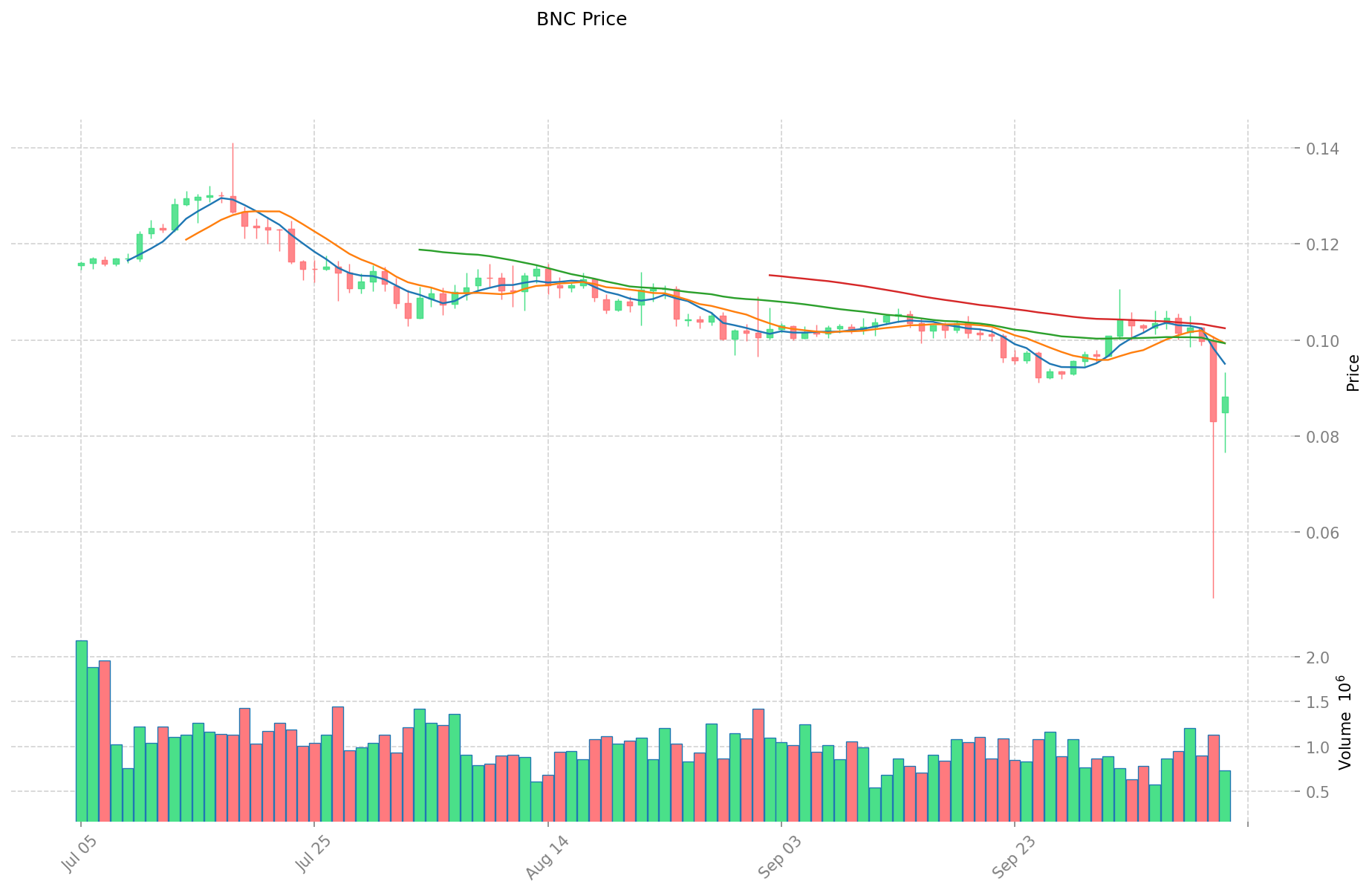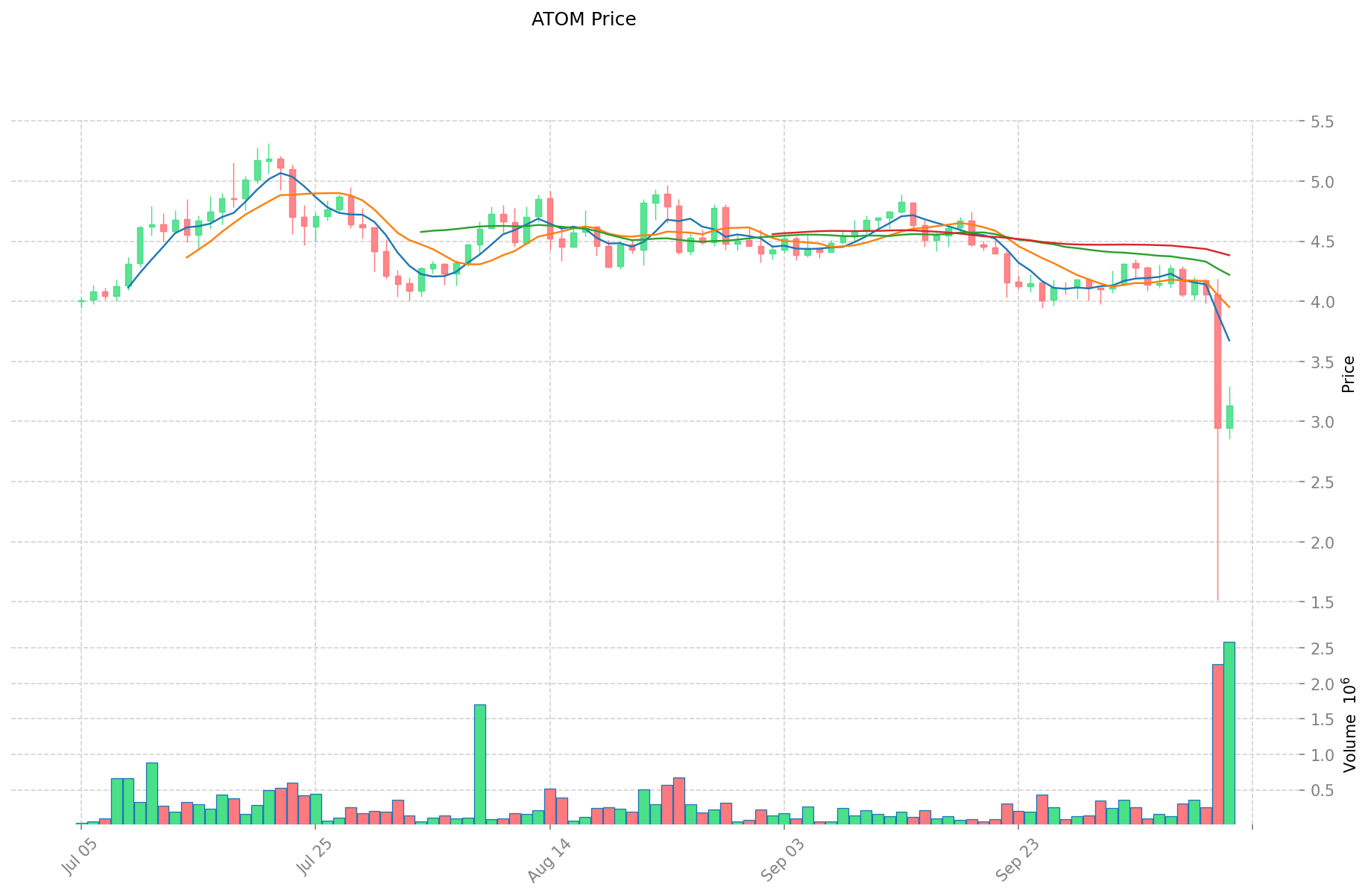BNC vs ATOM: Comparing Two Cutting-Edge Blockchain Networks for Enterprise Solutions
Introduction: BNC vs ATOM Investment Comparison
In the cryptocurrency market, the comparison between Bifrost (BNC) vs Cosmos (ATOM) has always been a topic that investors cannot avoid. The two not only have significant differences in market cap ranking, application scenarios, and price performance, but also represent different cryptocurrency positioning.
Bifrost (BNC): Since its launch in 2019, it has gained market recognition for providing liquidity for staking assets.
Cosmos (ATOM): Since its inception in 2014, it has been hailed as the "Internet of Blockchains," and is one of the cryptocurrencies with the highest global trading volume and market capitalization.
This article will comprehensively analyze the investment value comparison between BNC vs ATOM, focusing on historical price trends, supply mechanisms, institutional adoption, technological ecosystems, and future predictions, and attempt to answer the question investors care about most:
"Which is the better buy right now?" Here is the requested report in English using the provided template:
I. Price History Comparison and Current Market Status
BNC and ATOM Historical Price Trends
- 2021: BNC reached its all-time high of $6.14 due to the Polkadot ecosystem boom.
- 2022: ATOM was impacted by the broader crypto market downturn, dropping from its peak of $44.45.
- Comparative analysis: In the recent bear market cycle, BNC fell from $6.14 to a low of $0.077, while ATOM declined from $44.45 to around $3.08, showing relatively stronger resilience.
Current Market Situation (2025-10-12)
- BNC current price: $0.08816
- ATOM current price: $3.087
- 24-hour trading volume: BNC $64,901.72 vs ATOM $7,875,989.42
- Market Sentiment Index (Fear & Greed Index): 27 (Fear)
Click to view real-time prices:
- Check BNC current price Market Price
- Check ATOM current price Market Price


II. Core Factors Affecting Investment Value of BNC vs ATOM
Technical Innovation and Market Demand
-
ATOM: Utilizes a dual-core central processor technology (Atom™) that provides higher performance, stability and efficiency compared to previous multi-chip processors. This technological foundation gives ATOM a competitive edge in the semiconductor market.
-
BNC: Associated with BoringDAO, a cross-chain service provider driven by DAO governance that serves various crypto assets by providing cost-effective solutions.
-
📌 Market Differentiation: While ATOM focuses on processing power and hardware efficiency, BNC appears more oriented toward blockchain infrastructure services.
Staking Mechanisms and Liquidity
-
ATOM: Has a 21-day redemption period for staked assets, which creates potential liquidity risks for investors during the unstaking process.
-
BNC: Limited information available on specific staking mechanisms.
-
Liquidity Challenges: The extended redemption period for ATOM staking represents a significant consideration for investors seeking more liquid positions.
Technical Development and Ecosystem Building
-
ATOM: Part of the broader semiconductor technological innovation ecosystem, potentially benefiting from government investments in chip technology across countries like Japan, Taiwan, and South Korea.
-
Layer 1 Competition: The crypto market has seen explosive growth in Layer 1 protocols (potentially relevant to both assets), with multiple emerging Layer 2 networks challenging Ethereum and entering the competition.
Cross-Chain Functionality
-
BNC: Through BoringDAO, provides cross-chain services for various crypto assets, positioning it within the interoperability segment of the blockchain ecosystem.
-
Interoperability Value: Cross-chain functionality represents an increasingly important aspect of blockchain technology as the need for different networks to communicate grows.
III. 2025-2030 Price Prediction: BNC vs ATOM
Short-term Prediction (2025)
- BNC: Conservative $0.0581 - $0.0881 | Optimistic $0.0881 - $0.0960
- ATOM: Conservative $1.58 - $3.10 | Optimistic $3.10 - $3.22
Mid-term Prediction (2027)
- BNC may enter a growth phase, with estimated prices of $0.0699 - $0.1378
- ATOM may enter a consolidation phase, with estimated prices of $3.17 - $4.44
- Key drivers: Institutional inflows, ETFs, ecosystem development
Long-term Prediction (2030)
- BNC: Base scenario $0.1584 - $0.1842 | Optimistic scenario $0.1842 - $0.2044
- ATOM: Base scenario $5.65 - $5.88 | Optimistic scenario $5.88 - $6.63
Disclaimer: This analysis is based on historical data and market projections. Cryptocurrency markets are highly volatile and unpredictable. This information should not be considered as financial advice. Always conduct your own research before making investment decisions.
BNC:
| 年份 | 预测最高价 | 预测平均价格 | 预测最低价 | 涨跌幅 |
|---|---|---|---|---|
| 2025 | 0.0959854 | 0.08806 | 0.0581196 | 0 |
| 2026 | 0.107666559 | 0.0920227 | 0.056133847 | 4 |
| 2027 | 0.13778558871 | 0.0998446295 | 0.06989124065 | 13 |
| 2028 | 0.1497070374723 | 0.118815109105 | 0.08673502964665 | 34 |
| 2029 | 0.182595059672564 | 0.13426107328865 | 0.118149744494012 | 52 |
| 2030 | 0.204372205759983 | 0.158428066480607 | 0.126742453184485 | 79 |
ATOM:
| 年份 | 预测最高价 | 预测平均价格 | 预测最低价 | 涨跌幅 |
|---|---|---|---|---|
| 2025 | 3.22192 | 3.098 | 1.57998 | 0 |
| 2026 | 3.6655536 | 3.15996 | 2.527968 | 2 |
| 2027 | 4.43658384 | 3.4127568 | 3.173863824 | 10 |
| 2028 | 5.4160450416 | 3.92467032 | 2.6687758176 | 27 |
| 2029 | 6.631907906736 | 4.6703576808 | 2.755511031672 | 51 |
| 2030 | 5.87717810551872 | 5.651132793768 | 5.42508748201728 | 83 |
IV. Investment Strategy Comparison: BNC vs ATOM
Long-term vs Short-term Investment Strategies
- BNC: Suitable for investors focused on cross-chain functionality and ecosystem potential
- ATOM: Suitable for investors seeking established networks with broader adoption
Risk Management and Asset Allocation
- Conservative investors: BNC: 30% vs ATOM: 70%
- Aggressive investors: BNC: 60% vs ATOM: 40%
- Hedging tools: Stablecoin allocation, options, cross-currency portfolios
V. Potential Risk Comparison
Market Risks
- BNC: Higher volatility due to lower market cap and trading volume
- ATOM: Vulnerability to broader crypto market trends and sentiment
Technical Risks
- BNC: Scalability, network stability
- ATOM: Potential issues with the 21-day unstaking period
Regulatory Risks
- Global regulatory policies may impact both assets differently, with larger, more established networks like ATOM potentially facing greater scrutiny
VI. Conclusion: Which Is the Better Buy?
📌 Investment Value Summary:
- BNC advantages: Cross-chain functionality, potential for growth in interoperability services
- ATOM advantages: Established ecosystem, higher liquidity, broader market recognition
✅ Investment Advice:
- New investors: Consider a larger allocation to ATOM for its established position and higher liquidity
- Experienced investors: Explore a balanced portfolio with both BNC and ATOM to capture potential growth and stability
- Institutional investors: Conduct thorough due diligence on both assets, with a potential focus on ATOM for its larger market presence
⚠️ Risk Warning: Cryptocurrency markets are highly volatile. This article does not constitute investment advice. None
VII. FAQ
Q1: What are the main differences between BNC and ATOM? A: BNC focuses on cross-chain functionality and interoperability services, while ATOM is part of a broader ecosystem known as the "Internet of Blockchains". ATOM has a larger market cap and trading volume compared to BNC.
Q2: Which cryptocurrency has shown better price performance recently? A: In the recent bear market cycle, ATOM has shown relatively stronger resilience. While BNC fell from $6.14 to a low of $0.077, ATOM declined from $44.45 to around $3.08.
Q3: What are the key factors affecting the investment value of BNC and ATOM? A: Key factors include technical innovation, market demand, staking mechanisms, liquidity, ecosystem development, and cross-chain functionality. ATOM benefits from its established ecosystem, while BNC offers potential in the growing field of interoperability.
Q4: How do the staking mechanisms differ between BNC and ATOM? A: ATOM has a 21-day redemption period for staked assets, which can create potential liquidity risks. Limited information is available on BNC's specific staking mechanisms.
Q5: What are the long-term price predictions for BNC and ATOM? A: By 2030, BNC is predicted to reach $0.1584 - $0.2044 in optimistic scenarios, while ATOM is expected to reach $5.65 - $6.63. However, these predictions are subject to market volatility and should not be considered financial advice.
Q6: How should investors allocate their portfolio between BNC and ATOM? A: Conservative investors might consider 30% BNC and 70% ATOM, while aggressive investors might opt for 60% BNC and 40% ATOM. The exact allocation should depend on individual risk tolerance and investment goals.
Q7: What are the main risks associated with investing in BNC and ATOM? A: Both face market risks due to cryptocurrency volatility. BNC may have higher volatility due to its lower market cap. ATOM faces potential issues with its 21-day unstaking period. Both are subject to evolving regulatory risks in the cryptocurrency space.
Share
Content